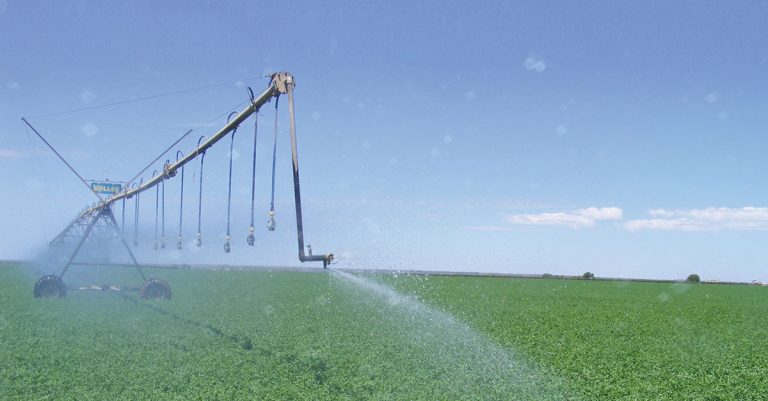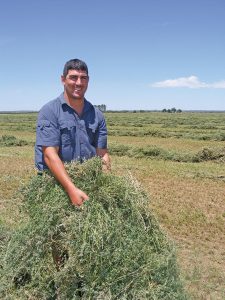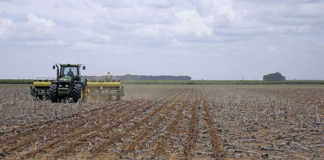
Photo: Annelie Coleman
Mechanisation is key to increased profit and long-term sustainability in commercial agriculture, says Attie Scholtz, who farms on Vaallus in Douglas. Attie irrigates 400ha lucerne, maize, wheat and barley on 17 centre pivot lands from the Vaal River.
Lucerne, contributing some 45% of the turnover, is rotated with a grain crop every three years. The enterprise also includes an 80-cow commercial Bonsmara/Beefmaster herd.
He is one of the few farmers to financially survive the 2010/2011 floods without external help. He ascribes this achievement to painstaking cash flow management and financial planning.
“Irrigation farming has changed dramatically since I was a child,” he recalls.
“In those days, they still used flood irrigation. Everything was done by hand, which called for an enormous workforce.

“Although my father later installed centre pivot irrigation, he still needed nearly 50 workers to produce 170ha of mainly maize and wheat. Since I started farming, I have invested between R12 million and R13 million in mechanising. I now have only 14 permanent workers.” Attie farms with his wife Cecile and three small daughters Annelike, Dané and Celine. He took over the farm nearly seven years ago after his father Gerrie passed away.
Business and profit
Profit remains the reason for any business. “Efficient and cost-effective cultivation practices are key for a farmer to remain competitive in a highly specialised industry. Farmers are price-takers, not price-makers.
“Consider the grape industry as an example. I lease cut-off portions of my farm not covered by the pivots to a grape producer. Using a self-propelled grape harvester, he completes the entire harvest in about a week with one or two workers,” Attie says.
“In the past, it would have taken between 60 and 70 workers at least three to four weeks. We are talking about thousands of rands saved on labour alone. This is the way forward for commercial agriculture.”
Specialised implements enable Attie to bale and load a 30ha lucerne land in one evening with one or two workers. He bales approximately 10ha of lucerne in 700kg bales per hour with his new Case IH Big Pack Baler. A front-end loader loads the bales onto waiting trucks and, an hour later, Attie can resume irrigation.
“Lucerne harvesting is night work,” he points out.
“We cut during the day and leave it to dry off for three to four days, depending on the weather. In the cool of the night and with moisture from dew, it becomes more pliable. This prevents the leaves, which hold the nutritional value of lucerne, from dropping off and consequently ensures top quality.
“In my father’s time, it would have taken three to four days. I can now harvest lucerne every three or four weeks as the process has been accelerated significantly,” he says.
“We now manage nine cuttings per cycle. At the price of R1 800/t for top quality lucerne, mechanisation is an imperative.”
And Attie does produce the best quality lucerne. He supplies prime grade lucerne to a leading dairy farmer in the Western Cape at a premium of about R250/t over the normal market price.
He strives for a protein content of between 24% to 25% but 28% is not uncommon. With a standing order for 200t a month, coupled with the premium, the improved production through mechanisation makes good business sense.
“I consider my clients as partners. By mechanising I can provide them a steady and reliable supply of top quality lucerne. “I wonder if we produced much more than 8 000t annually five years ago. Mechanisation has pushed this up to between 70 000t and 80 000t annually.
“The entire industry exploded since it became independent of a large labour force. The Douglas producers are increasingly exporting lucerne to the Middle East and other international markets.”
Attie nevertheless advises farmers to do their homework before embarking on large-scale mechanisation. It often makes financial sense to use a contractor rather than to incur a large debt to buy expensive equipment. But should the contractor’s cost exceeds the purchase cost of equipment crucial to the growth of the enterprise, a farmer should reconsider outsourcing.
“I am addicted to auctions,” he quips.
“I upgrade my fleet of implements and machinery regularly. Over the years I saved a lot of money by buying on auctions and upgrading what I bought. This keeps the cost of mechanisation in check. “Lucerne production is heavy on equipment. A tractor is used for about 200 hours per year in wheat and maize production, but up to 1 000 hours per year for lucerne. I replace a tractor after 4 500 hours.
“Other equipment such as balers and cutters are replaced when the maintenance cost becomes too high and when they run too much down time because of breakage.
“I can’t afford to lose even one cutting of lucerne to defective equipment. I don’t restrict myself to any specific manufacturer, but buy what I need and can afford at the time,” he explains.
Paradoxically, Attie’s workers have also benefited from mechanisation. He reduced their number dramatically over the years and only kept those essential to the operation.
“A streamlined workforce means that the workers are now earning decent wages that enable them to build a future for themselves and their families. But I am very concerned about the long-term effect of the new increased minimum farm worker wage of R105 per day as recently announced by the minister of Labour, Mildred Oliphant.
“Coupled with mechanisation, this will have an alarming effect in rural areas where unemployment already is an immense problem. It will be exacerbated a thousandfold when farmers start retrenching workers, all because mechanisation has become cheaper than labour. We can expect disastrous socio-economic problems.” Long-term employee Anthony Hoogstander confirms that he and his fellow workers have a good relationship with Attie and are proud to be part of the team.
Attie switched from a weekly wage system to a monthly one. “It was a very wise decision,” says Anthony. “We can do much more with one big sum of money than with ‘bietjie-bietjie’ every week. No, we don’t have any problems on this farm.
We are a happy team.”
Attie took offence with President Jacob Zuma’s 2013 State of the Nation address.
“It seems as if politicians and people in power have no idea of what is really happening on commercial farms. He called for the improvement of working and living conditions on farms, creating the impression that farm workers are left in squalor. This is not true. Most workers in my district are living better than people in squatter camps and informal settlements. What will happen when farmers can no longer afford to employ them?”
Bright future
He nevertheless foresees a bright future. “We farm in one of the most taxing parts of the world. We have to manage in a harsh climate and negative policy framework. The fact that we still supply enough to ensure food security is testament to our dedication to our country. We will, however, have to work smarter. “
Email Attie Scholtz [email protected]












